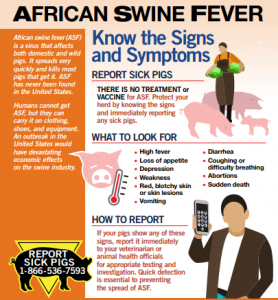African swine fever (ASF) struck the largest pig producer in the world, China, last August, and more recently found its way to Vietnam. Here in the United States, the challenge is to keep the highly contagious and deadly disease out of the country.

African swine fever reported in China, First reported case in East Asia
Last week, the US Department of Agriculture (USDA)-trained detector dogs played a major role in the seizure of roughly 1 million pounds of pork smuggled from China.
The USDA and Secretary Sonny Perdue is sharing information about the importance of keeping ASF out of the United States. It is vital for everyone to know about ASF and how to prevent it, while keeping the U.S. pig population healthy.
Concerning educating and informing the public, they have an updated webpage dedicated to ASF. They also put out four very good infographics– African Swine Fever Risk Pathways , Signs and Symptoms of African Swine Fever , Traveler Tips and Biosecurity.
African Swine Fever in Asia: ‘Just the tip of the iceberg’
In addition, USDA is monitoring the recent outbreaks of ASF is Asia and Europe, and has proactively taken steps to increase our safeguarding efforts to keep the disease out of the United States. These steps include:
- Working with U.S. Customs and Border Protection at ports of entry, paying particular attention to cargo, passengers and products arriving from China and other ASF affected countries;
- Increasing detector dog teams with U.S. Customs and Border Protection to sniff out illegal products at key U.S. commercial sea and airports and were placed at Atlanta’s Hartsfield-Jackson and Chicago’s O’Hare airports);
- Collaborating with states, industry and producers to ensure everyone follows strict on-farm biosecurity protocols and best practices (including for garbage feeding in states where that is allowed);
- Restricting imports of pork and pork products from affected countries;
- Coordinating closely on response plans with the U.S. pork industry, producers and States to be ready should a detection ever occur in the United States; and
- Expanding the testing capabilities and testing capacity of the National Animal Health Laboratory Network.


Something is odd about this story. Why would anybody smuggle a million pounds of Chinese pork into the U.S.? The U.S. is among the largest pork producers and we have some of the lowest pork prices in the world. This would be like smuggling corn or coal into the U.S.